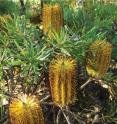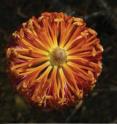Botany student proves 'New England Banksia' a distinct species
The New England Banksia is largely restricted to the eastern edge of the New England Tableland, and is common in places along Waterfall Way. Ms Stimpson's research has raised this flowering plant, until now classified as a variety of the Hairpin Banksia (B. spinulosa), to the taxonomic level of a distinct species. The study was published in the open access journal PhytoKeys.
"I love the Proteaceae -- the family of flowering plants that includes the Banksia and Grevillea genera in Australia and Protea in South Africa," Ms Stimpson said. "Surprisingly, molecular evidence in recent years has shown the family's closest relatives are the Sacred Lotus and the plane trees. Species of Banksia survive in poor soil and still manage to produce marvellous flowers."
Margaret Stimpson wrote the paper in collaboration with Ian Telford, the Curator of the N.C.W. Beadle Herbarium at the University of New England, Professor Jeremy Bruhl, the Director of the herbarium, and Dr Peter Weston, Senior Principal Research Scientist at the National Herbarium of NSW, an international specialist in Proteaceae systematics.
Margaret's first project as an undergraduate student of botany at UNE was on the Proteaceae, and she's been collecting specimens ever since. Now working towards enrolling in a doctoral degree program, she said: "There are still species of Banksia out there that merit description, and I hope to test these in a PhD project."
Margaret established the species rank of the New England Banksia by detailed studies of its leaves, flowers, stem and fruit, and considerations of its ecology and distribution. She explained that it has two growth forms, the more common being a multi-stemmed small shrub with many flowers but few seeds. This form occurs where there has been regular burning, and the seeds need exposure to fire to open. The less common form, found where burning has not occurred, is a single-stemmed tree with many flowers and many seeds that open spontaneously without exposure to fire.
Source: Pensoft Publishers
Other sources
- 'New England banksia' a distinct species, botany student showsfrom Science DailyTue, 28 Aug 2012, 16:02:58 UTC
- Botany student proves 'New England Banksia' a distinct speciesfrom PhysorgTue, 28 Aug 2012, 15:30:55 UTC

